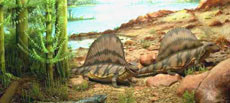 |
 |
 |
 |
 |
Produced
by the Population Genetics and Evolution class, Furman University |
||||
 |
 |
 |
 |
 |
Produced
by the Population Genetics and Evolution class, Furman University |
||||
 |
Cynodonts
|
 |
||
| Cynodonts,
literally meaning “dog teeth”, were one of the most diverse
and successful groups of therapsids (White 2004). They evolved in the
late Permian, but radiated dramatically in the Triassic. Their fossils
have been found worldwide. They were carnivorous animals which normally
ate small animals and insects, and they were only about one meter long
(Agaric 2007). Like all therapsids, Cynodonts are an important intermediate
between mammals and reptiles, as they have many characteristics similar
to each group. But overall, they are more mammalian-like than other therapsids.
Their backbone moved side to side like a reptile’s when it moved,
and many walked upright (Dinosaur Den 2007). However, they were probably
warm-blooded and covered with hair, which is a mammalian characteristic.
In fact, most paleontologists agree that modern mammals descended from
one specific group of cynodonts (White 2004). Another similarity that
Cynodonts shared with reptiles is that they laid eggs. However, they did
not abandon the eggs once they were laid; they probably displayed some
level of parental care (Dinosaur Den 2007).
Page by Lindsay Gerzel |
 |
| The cynodont, Dvinia prima. Photo from: www.math.com | |
|
Agaric. 2007. Cynodonts: Triassic mammal-like reptiles. Associated Content. Accessed on March 17, 2010. White AT. 2004. Cynodontia: overview. www.palaeos.com. Accessed on March 17, 2010. Dinosaur Den. 2007. Special feature- early mammals: Cynodont. Accessed on March 17, 2010. |